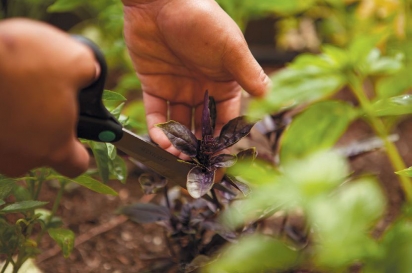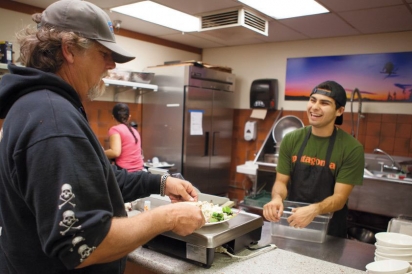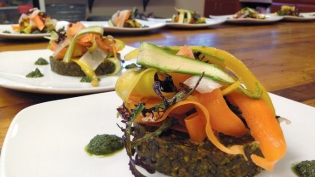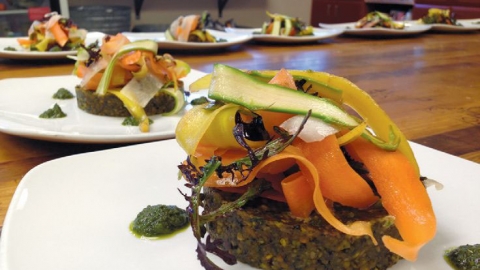Gearing Up for Great Food at Patagonia
Patagonia employees enjoy eating like family
Patagonia founding father and company owner Yvon Chouinard sits in a hand-painted, battered bistro chair at one of the distressed wooden tables in the company's modest Patagonia Café, cracking open a live sea urchin to consume with the kind of enthusiasm more often associated with sea otters.
Earlier, Chouinard's daughter, Claire, a designer with the company, was going to check the employee café's fridge to see what might be taken home for dinner – maybe some sun-dried tomato fusilli or a container of avogolemeno, a Greek egg, lemon, rice and chicken soup. This wasn't the privilege of being the boss's daughter, but a perk of any employee lucky enough to work at the Ventura corporate headquarters of the renowned, environmentally sensitive, outdoor clothing manufacturer.
The café at Patagonia is like an enlightened, adventurous home kitchen where the adults in charge want to be sure the family eats nutritionally sound meals sourced as locally and organically as possible while inspired by global cuisines.
The Santa Barbara Channel sea urchin was a leftover from the previous evening's employee supper club prepared by executive chef Tracy On and sous chef Jacob Kneuer. The elaborate four-course meal included fresh sea urchin and uni butter, served with roasted Easter egg radishes, followed by Peruvian ceviche with wild Alaskan halibut, crispy roasted pork belly, a harissa-spiced rack of lamb and cherimoya-strawberry pudding with cheese plate for dessert. Much of the produce for this $40 dinner with wine pairings was donated, says Micah Knox, Patagonia's operations manager for the cafe and farmers' market, with the proceeds benefitting Ventura County's Students for Eco-Education and Agriculture (SEE AG).
Long considered one of the better companies to work for, Patagonia's progressive corporate culture extends to such employee perks as child daycare, paid maternity and paternity leave and dropping everything when the surf's up. Wetsuits hanging to dry on the building walls and stair banisters are proof of the latter.
Much of the facilities' energy comes from hundreds of solar panels, many shading the parking lot, and the rest is purchased wind power. The food program is equally enlightened. The Patagonia Café serves 250 – 300 employees (of the campus's 500) a subsidized breakfast and lunch daily.
If the café is fairly empty, it's because the outdoor enthusiast employees prefer to dine at the numerous tables spread about the native-plant-landscaped grounds. The two hot entrée offerings the day I visited were a Brazilian Moqueca stew, with local black cod, and a vegetarian version of the Brazilian feijoada stew – featuring black beans rather than the usual meat and sausage – and served over organic brown rice.
The day before, Knox grilled local Watkins Cattle Company organic tri-tip beef and flat iron steaks. The salad bar features organic produce, grass-fed beef, Patagonia Provisions salmon and a variety of proteins and organic grains, including prepared salads such as "forbidden rice ramen," green bean and morel salad, a spinach with heirloom carrots pasta salad and a berry and Thai basil salad with kale and red frill lettuce.
Ojai's organic Rio Gozo Farm, which also sells at the company's Thursday on-campus, employee-only farmers' market, is a main source of the featured produce.
The boyish Knox, dressed in a baseball cap, gray zippered hoodie, surf shorts and flip-flops, credits such menu creativity to chef On, a 32-year-old native of the San Francisco Bay Area. The dark-haired, petite On, whose mother is Filipino and father Chinese-American, graduated from UCSB with a degree in communications and art before working five years in marketing for Goleta-based Deckers Outdoor Corporation, manufacturer of shoe brands such as Teva and Ugg. While there, she cooked for coworkers and did rehearsal dinners for friends, on the side.
"I always loved cooking; my mom and dad are both great cooks."
"I didn't want it to be a hobby or a retirement career," she says of her decision to enroll in Santa Barbara Community College's culinary arts program. "I also wanted a challenge and a change."
She started her professional career with a stage (pronounced "stahj" – French for an unpaid internship) – at Solvang's haute farm-to-table restaurant Root 246 when it opened in 2009 under the tutelage of celebrated chef Bradley Ogden. This worked into a full-time position on the line and promotion to different stations.
Ogden helped her get a second stage at Chez Panisse in Berkeley under Alice Waters.
"It was phenomenal," On says. "I had not eaten there before, but knew her reputation, her style of cooking and her books and what she stood for." On didn't stay at the landmark restaurant, wanting instead to return to the Santa Barbara/Ventura area. She landed at Santa Barbara's Hungry Cat, and found her way to Patagonia two years ago through an employee friend.
Knox, 38, who grew up in the Ventura area and has a culinary degree from Casa Armendariz in St. Sebastian, Spain, hired On as his sous chef when he headed the kitchen.
"The culinary world is always evolving. If you don't evolve with it, you will get passed up. After creating the farmers' market – which ended up taking a lot of my time – it made sense to make Tracy executive chef, with her culinary diversity. It allows me to find local, organic farmers to provide the best produce for our employees," he says of why he gave up his toque.
He got out of the kitchen (where flip-flops are not allowed) and became a manager. On, in turn, brought in Kneuer, with whom she'd worked at Hungry Cat.
"They've taken it up to a whole new level," Knox says.
Kneuer, a 28-year-old L.A. native with 11 years' experience cooking everywhere from Italy to Yellowstone, finds working with On a great adventure. The team plans a new menu each week, based on what they have on hand and where they want to go, inspired by a cookbook shelf that includes tomes like Plenty: Vibrant Recipes from London's Ottolenghi by Yotam Ottolenghi with its innovative take on vegetarian dishes. A bottle of garam masala spice blend sits on the shelf alongside the books.
"We try to do new things," Kneuer says. They also work to meet employee dietary preferences, offering vegan, gluten-free and pescatarian choices. "We go toward vegetarian, reworking dishes without flour or meat; it's a great experience."
Many of Patagonia's employees are runners and athletes, so the menu is high on protein but light on sugar. The chefs neither bake nor offer pastries or ice cream for sale. If a department wants Danish pastries for a breakfast meeting or a special-occasion cake, they have to bring it in. Sodas, other than a few high-end imports and artisanal domestic labels, aren't offered, and the primary sweets are the high-energy portable stuff outdoors people would throw into a rucksack – organic dark chocolate bars and non-GMO, non-corn-syrup gummy bears.
"We're trying to sway people away from sweets," Knox says.
This is all what the company considers part of the nutritional education they offer employees, along with classes they hold in the café on gluten-free baking and juicing, listed on the café's "Brain Food" announcement board.
On has expanded her culinary repertoire and education while cooking at Patagonia. "Rio Gozo opened me up to new vegetables," she says, "such as kohlrabi, Easter egg radishes and cardoons." She serves the latter peeled, blanched and sautéed.
Keeping with the company's conservation policies, there's as little waste as possible in the kitchen, which makes for even more creative, frugal home-cook-style thinking. This day, the greens from beets used in the supper club dinner went into the black bean stew.
"You can't cook like that at a restaurant," On says. "Usually they only want the beet. Patagonia's philosophy is to minimize waste, to use as much as possible, and educate people about the nutritional benefits of the greens."
"We're trying to bridge the gap of farm-to-table of a good restaurant and doing it in an institutional setting," she says. But even more than these efforts, she's especially proud that none of her kitchen staff are out-sourced workers. They are all Patagonia employees who receive company benefits, including health care. In today's all-too-often noncollegial corporate culture, that has to be considered among Patagonia's healthiest offerings.
Silicon Valley businesses may provide more in the way of free and varied dining, while their high-tech fast-trackers work on the Next Big Thing, but Patagonia's people seem to be enjoying another kind of nourishment. What they lack in million-dollar stock options, they make up for in a workplace that seems infinitely more reasonable, sustainable and real, rather than virtual.
"I love working here," says On, who commutes from the Santa Barbara home she shares with her boyfriend and Labrador-mix puppy. "Every day I'm cooking a family meal. That's what it's like, it's like feeding family."
MAKING "FAMILY" MEALS
Not everyone can work at Patagonia, but here are a few ways you can make your workday meals more healthful and Patagonia-like.
• Make extra portions of dinner's components so you can bring leftovers for tomorrow's lunch.
• Bring meals made with ingredients sourced from local farmers' markets, health-oriented markets or butchers.
• Explore cuisines that are new to you.
• Gather a group of like-minded coworkers for potluck lunches.
• Eat with your work family.









